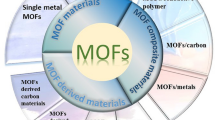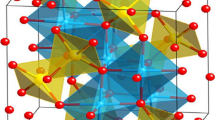Abstract
The processability, conductivity, and stability of polyaniline (PANI) for supercapacitor application can be improved by altering the polymerization, oxidation state, and activating conditions. In this work, PANI has been created and coated concurrently on a different substrate via a one-step electrochemical polymerization method for supercapacitors application. Concentration of 0.2 M was used to exploit the condition parameter of the PANI-WE (PANI-Working electrode). The PANI-WE was then conducted by varying the substrate which are carbon, stainless steel, and carbon felt via electrode pretreatment and activating agent. The pretreatment enables the incorporation of large amount of active energy storage materials in the supercapacitor devices. The PANI composite’s potential to store energy was conducted with two different electrolytes of C6FeK4N6 and H2SO4 and compared. The electrodes made of PANI-Carbon felt with treatment using H2SO4 as both activating agent and electrolyte had the highest specific capacitance. Due to the synergistic relationship between PANI and carbon felt, PANI-Carbon Felt demonstrated better electrochemical performance than pure PANI. As a result of its good porosity and quick pseudocapacitive charge storage response, PANI increased capacitance in this circumstance, whereas carbon felt aided in improving conductivity and stability. Carbon felt gives highest yield of PANI with a weight of 0.0274 g due to the porous morphology of the carbon felt which has a high surface area and porosity.






Similar content being viewed by others
Data availability
All data generated or analyzed during this study are included in this published article.
References
M. Choudhary, S. Siwal, D. Nandi, K. Mallick, Charge storage ability of the gold nanoparticles: towards the performance of a supercapacitor. Appl. Surf. Sci. 424, 151–156 (2017). https://doi.org/10.1016/j.apsusc.2017.01.258
T.-F. Yi, H. Chang, T.-T. Wei, S.-Y. Qi, Y. Li, Y.-R. Zhu, Approaching high-performance electrode materials of ZnCo2S4 nanoparticle wrapped carbon nanotubes for supercapacitors. J. Materiom. 7, 563–576 (2021). https://doi.org/10.1016/j.jmat.2020.11.015
S.Y. Attia, S.G. Mohamed, Y.F. Barakat, H.H. Hassan, W.A. Zoubi, Supercapacitor electrode materials: addressing challenges in mechanism and charge storage. Rev. Inorg. Chem. 42, 53–88 (2022). https://doi.org/10.1515/revic-2020-0022
T.-F. Yi, L.-Y. Qiu, J. Mei, S.-Y. Qi, P. Cui, S. Luo, Y.-R. Zhu, Y. Xie, Y.-B. He, Porous spherical NiO@NiMoO4@PPy nanoarchitectures as advanced electrochemical pseudocapacitor materials. Sci. Bull. 65, 546–556 (2020). https://doi.org/10.1016/j.scib.2020.01.011
T. Wei, N. Zhang, Y. Ji, J. Zhang, Y. Zhu, T. Yi, Nanosized zinc oxides-based materials for electrochemical energy storage and conversion: batteries and supercapacitors. Chin. Chem. Lett. 33, 714–729 (2022). https://doi.org/10.1016/j.cclet.2021.06.037
S. Yetiman, H. Peçenek, F.K. Dokan, M.S. Onses, E. Yılmaz, E. Sahmetlioglu, Microwave-assisted fabrication of high-performance supercapacitors based on electrodes composed of cobalt oxide decorated with reduced graphene oxide and carbon dots. J. Energy Stor. (2022). https://doi.org/10.1016/j.est.2022.104103
P. Forouzandeh, V. Kumaravel, S.C. Pillai, Electrode materials for supercapacitors: a review of recent advances. Catalysts (2020). https://doi.org/10.3390/catal10090969
M.O. Faruk, M.M. Rahman, D.R. Sarker, M.M. Rahman, Enhancement of electrical conductivity of polyaniline synthesized by using carbon nanofiber. J. Sci. Res. 13, 243–252 (2021). https://doi.org/10.3329/jsr.v13i1.48356
Y. Liu, S.P. Jiang, Z. Shao, Intercalation pseudocapacitance in electrochemical energy storage: recent advances in fundamental understanding and materials development. Today Adv. Mater. (2020). https://doi.org/10.1016/j.mtadv.2020.100072
H. Peçenek, F.K. Dokan, M.S. Onses, E. Yılmaz, E. Sahmetlioglu, Highly compressible binder-free sponge supercapacitor electrode based on flower-like NiO/MnO2/CNT. J. Alloys Compd. (2022). https://doi.org/10.1016/j.jallcom.2022.165053
D.J. Ahirrao, A.K. Pal, V. Singh, N. Jha, Nanostructured porous polyaniline (PANI) coated carbon cloth (CC) as electrodes for flexible supercapacitor device. J. Mater. Sci. Technol. 88, 168–182 (2021). https://doi.org/10.1016/j.jmst.2021.01.075
H. Peçenek, F.K. Dokan, M.S. Onses, E. Yılmaz, E. Sahmetlioglu, Outstanding supercapacitor performance with intertwined flower-like NiO/MnO2/CNT electrodes. Mater. Res. Bull. (2022). https://doi.org/10.1016/j.materresbull.2022.111745
H. Xu, G. Zhang, Y. Wang, M. Ning, B. Ouyang, Y. Zhao, Y. Huang, P. Liu, Size-dependent oxidation-induced phase engineering for MOFs derivatives via spatial confinement strategy toward enhanced microwave absorption. Nanomicro. Lett. 14, 102 (2022). https://doi.org/10.1007/s40820-022-00841-5
F. Liu, S. Luo, D. Liu, W. Chen, Y. Huang, L. Dong, L. Wang, Facile processing of free-standing polyaniline/SWCNT film as an integrated electrode for flexible supercapacitor application. ACS Appl. Mater. Interfaces 9, 33791–33801 (2017). https://doi.org/10.1021/acsami.7b08382
E. Song, J.W. Choi, Conducting polyaniline nanowire and its applications in chemiresistive sensing. Nanomaterials (Basel) 3, 498–523 (2013). https://doi.org/10.3390/nano3030498
H. Cao, X. Peng, M. Zhao, P. Liu, B. Xu, J. Guo, Oxygen functional groups improve the energy storage performances of graphene electrochemical supercapacitors. RSC Adv. 8, 2858–2865 (2018). https://doi.org/10.1039/c7ra12425b
J. Du, Y. Li, Q. Zhong, J. Yang, J. Xiao, F. Chen, Y. Wang, K. Luo, Chen, W. Li, Boosting the utilization and electrochemical performances of polyaniline by forming a binder-free nanoscale coaxially coated polyaniline/carbon nanotube/carbon fiber paper hierarchical 3D microstructure composite as a supercapacitor electrode. ACS Omega 5, 22119–22130 (2020). https://doi.org/10.1021/acsomega.0c02151
A. Rana, N. Baig, T.A. Saleh, Electrochemically pretreated carbon electrodes and their electroanalytical applications—A review. J. Electroanal. Chem. 833, 313–332 (2019). https://doi.org/10.1016/j.jelechem.2018.12.019
X. Wang, M.G. Say, R. Brooke, V. Beni, D. Nilsson, R. Lassnig, M. Berggren, J. Edberg, I. Engquist, Upscalable ultra thick rayon carbon felt based hybrid organic-inorganic electrodes for high energy density supercapacitors. Energy Storage (2022). https://doi.org/10.1002/est2.348
E. Roubaud, R. Lacroix, S. Da Silva, J. Esvan, L. Etcheverry, A. Bergel, R. Basseguy, B. Erable, Industrially scalable surface treatments to enhance the current density output from graphite bioanodes fueled by real domestic wastewater. iScience 24, 102162 (2021). https://doi.org/10.1016/j.isci.2021.102162
F. Huerta, C. Quijada, F. Montilla, E. Morallón, Revisiting the redox transitions of polyaniline. Semiquantitative interpretation of electrochemically induced IR bands. J. Electroanal. Chem. (2021). https://doi.org/10.1016/j.jelechem.2021.115593
S. Gutić, M. Cacan, F. Korać, Electrodeposition of polyaniline films on stainless steel and their voltammetric behavior in corrosive environments. Bull. Chem. Technol. Bosnia Herzegovina 48, 45–50 (2017)
C. Zhong, Y. Deng, W. Hu, J. Qiao, L. Zhang, J. Zhang, A review of electrolyte materials and compositions for electrochemical supercapacitors. Chem. Soc. Rev. 44, 7484–7539 (2015). https://doi.org/10.1039/c5cs00303b
A. Eftekhari, L. Li, Y. Yang, Polyaniline supercapacitors. J. Power Sources 347, 86–107 (2017). https://doi.org/10.1016/j.jpowsour.2017.02.054
K. Naga Mahesh, R. Balaji, K.S. Dhathathreyan, Studies on noble metal-free carbon-based cathodes for magnesium–hydrogen peroxide fuel cells. Ionics 21, 2603–2607 (2015). https://doi.org/10.1007/s11581-015-1434-y
T.X.H. Le, M. Bechelany, M. Cretin, Carbon felt based-electrodes for energy and environmental applications: a review. Carbon 122, 564–591 (2017). https://doi.org/10.1016/j.carbon.2017.06.078
P. Liu, S. Gao, G. Zhang, Y. Huang, W. You, R. Che, Hollow engineering to Co@N-Doped carbon nanocages via synergistic protecting-etching strategy for ultrahigh microwave absorption. Adv. Funct. Mater. (2021). https://doi.org/10.1002/adfm.202102812
P. Liu, Y. Wang, G. Zhang, Y. Huang, R. Zhang, X. Liu, X. Zhang, R. Che, Hierarchical engineering of double-shelled nanotubes toward hetero-interfaces induced polarization and microscale magnetic interaction. Adv. Funct. Mater. (2022). https://doi.org/10.1002/adfm.202202588
A.A. Abaalkhail, B.A. Alshammari, G.N. Almutairi, F.S. Alenazey, M.F. Alotibi, A.M. Alenad, A.G. Alharbi, T.S. Almoneef, B.M. AlOtaibi, Enhancing the performance of a metal-free self-supported carbon felt-based supercapacitor with facile two-step electrochemical activation. Nanomaterials (Basel) (2022). https://doi.org/10.3390/nano12030427
G. Lou, Y. Wu, X. Zhu, Y. Lu, S. Yu, C. Yang, H. Chen, C. Guan, L. Li, Z. Shen, Facile activation of commercial carbon felt as a low-cost free-standing electrode for flexible supercapacitors. ACS Appl. Mater. Interfaces 10, 42503–42512 (2018). https://doi.org/10.1021/acsami.8b16881
A.C. Rodrigues, M.G.C. Munhoz, B.S. Pinheiro, A.F. Batista, G.A. Amaral-Labat, A. Cuña, J.T. Matsushima, J.S. Marcuzzo, M.R. Baldan, N-activated carbon fiber produced by oxidation process design and its application as supercapacitor electrode. J. Porous Mater. 27, 141–149 (2019). https://doi.org/10.1007/s10934-019-00799-7
A. Pina, A. Amaya, J. Marcuzzo, A. Rodrigues, M. Baldan, N. Tancredi, A. Cuña, Supercapacitor electrode based on activated carbon wool felt. C (2018). https://doi.org/10.3390/c4020024
Acknowledgements
The author would like to express gratitude to Universiti Sains Malaysia for the USM Fellowship Program and Japan Student Services Organization for the JASSO scholarship program.
Funding
The authors have not disclosed any funding.
Author information
Authors and Affiliations
Contributions
NDZ: Collected the data, performed the analysis, wrote the paper. ALA: Supervising, checking, performed the analysis. NFCL: Performed the analysis, wrote the paper, checking. LSC: Supervising, checking, performed the analysis. NN: Supervising, checking, performed the analysis.
Corresponding authors
Ethics declarations
Competing interest
The authors declare that they have no known competing financial interests or personal relationships that could have appeared to influence the work reported in this paper.
Additional information
Publisher’s Note
Springer Nature remains neutral with regard to jurisdictional claims in published maps and institutional affiliations.
Rights and permissions
Springer Nature or its licensor (e.g. a society or other partner) holds exclusive rights to this article under a publishing agreement with the author(s) or other rightsholder(s); author self-archiving of the accepted manuscript version of this article is solely governed by the terms of such publishing agreement and applicable law.
About this article
Cite this article
Zaulkiflee, N.D., Ahmad, A.L., Che Lah, N.F. et al. Collation of PANI as electrode material for supercapacitor: effect of different substrate and its performances. J Mater Sci: Mater Electron 34, 1013 (2023). https://doi.org/10.1007/s10854-023-10326-9
Received:
Accepted:
Published:
DOI: https://doi.org/10.1007/s10854-023-10326-9




